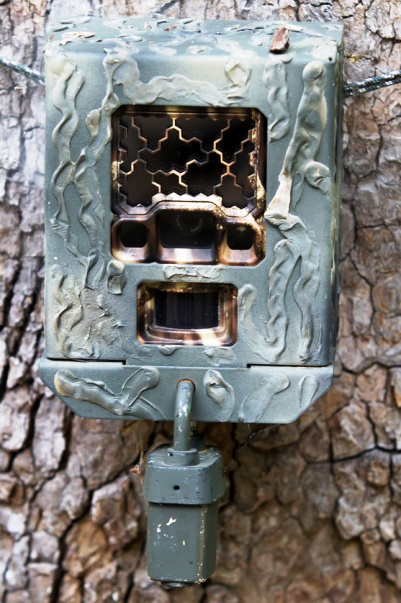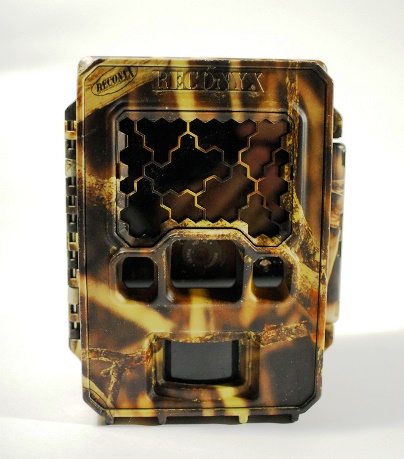Abstract
The North American Wood Ape Conservancy sent game cameras to a bioacoustics lab to determine whether or not the cameras produce detectable audio emissions potentially capable of deterring wildlife from approaching the vicinity of the cameras.
Introduction
Many observers note that the paucity of photographic evidence supporting the existence of an undocumented ape in North America is made even more remarkable in light of the (perceived) abundance of cameras available to capture images, particularly game cameras of the type used by hunters and wildlife researchers. Believing that high quality images could serve to help establish the existence of an unrecognized primate species as an important step in the scientific documentation process, the North American Wood Ape Conservancy invested tens of thousands of dollars in state-of-the-art game cameras. Operation Forest Vigil (2006-2011) was an ambitious five-year project during which scores of Cuddeback and Reconyx game cameras were deployed in remote locations where wood ape activity was strongly indicated by means of reports and member investigations and experiences.
Although thousands of images of native wildlife species were obtained, the operation failed to obtain a single photo of a wood ape.
NAWAC members initially hypothesized that animals of all types would ignore the cameras and behave normally in their presence. However, we soon learned this was not the case. For example, black bears (Ursus americanus) demonstrated great interest in the cameras, so much so that metal bear boxes had to be acquired to prevent camera destruction. As the operation progressed and years passed, speculation arose regarding whether the apes intentionally avoided the cameras, especially after learning that alpha coyotes have been known to facultatively avoid game cameras (Sequin, Jaeger, Brussard, & Barrett, 2003). Speculation also arose regarding the possibility that a subtle deficiency in the cameras themselves was responsible for the lack of photos.

The failure of the cameras, over a five-year period of extensive use, to photo-capture wood apes conflicted with the unequivocal experiences, observations, and physical trace evidence findings of members indicating that the creatures inhabited the area. Of special interest was the observation that, on a few occasions, the target species had been in the immediate vicinity of game cameras, yet no photos were captured. Upon further investigation, researchers noted that at least some of the game cameras were not operational at the time of nearby activity, leading us to wonder if noise was a factor. Although humans seem to be unable to detect sounds coming from operational cameras, some primates have been documented to have the ability to hear sounds above the range of human hearing (Heffner, 2004), leading us to hypothesize that game cameras generate sound emissions that may serve to alert animals to the presence of the cameras, enabling some species—particularly the wood ape—to remain undetected.
Materials and Methods
The capability to detect and quantify any high frequency or low frequency sounds from electronic equipment is a specialty, requiring extremely sensitive sensors and microphones. We explored different possibilities for the experiments we desired, but it was obvious an audiology laboratory was best suited to conduct this kind of analysis.

We contacted Martin L. Lenhardt, Ph.D., at the Bioacoustics Lab at Virginia Commonwealth University in Richmond, VA. The bioacoustics lab, established in 1971, is part of the School of Engineering within the biomedical engineering program. The lab is directed at an understanding of the evolutionary biology of animal hearing. According to the lab’s web site, “Most projects over the last 25 years have been directed toward the study of bioeffects of noise, sound, vibration and ultrasound on hearing and behavior,” (Bioacoustics Lab, Virginia Commonwealth University, n.d.). The VCU Bioacoustics Lab sounded like the ideal place to address our questions, and Dr. Lenhardt generously agreed to conduct the necessary experiments at no cost.
A Reconyx HC600 was selected for evaluation and was sent to the lab in January 2013. Tarun Sinha performed the tests under the direction of Dr. Lenhardt. The first measurements were obtained using two different piezo sensors with wide frequency responses. The batteries and memory card were removed for the control measurements. The second round of measurements were obtained using a high frequency microphone and a Rion hand-held FFT signal analyzer.

Results
On 19 February 2013, following the first round of tests, Dr. Lenhardt notified us that the two piezo sensors with wide frequency responses detected no ultrasound and added, “We are not picking up any very low frequencies either.”
On 27 February 2013, Dr. Lenhardt relayed his final results after assessing the camera again. “There is no ultrasound. The camera operation is very low level. I can’t imagine sound is causing avoidance.”
After measurements from testing indicating no detectable levels of either low frequency (infrasound) or high frequency (ultrasound) sound waves, we must conclude that sound frequencies that are undetectable to humans are not responsible for the seeming avoidance of our game cameras by any animal species, including the North American wood ape.
References
Bioacoustics Lab, Virginia Commonwealth University. (n.d.). Retrieved from http://biomedical.egr.vcu.edu/research/bioacoustics-lab/
Heffner, R. S. (2004). Primate hearing from a mammalian perspective. Retrieved from http://psychology.utoledo.edu/images/users/74/primate_hearing_from_a_mammalian_perspective.pdf
Lenhardt, M. (2013). Personal communication with Dr. Martin Lenhardt, Biomedical Engineering, Virginia Commonwealth University.
Sequin, E. S., Jaeger, M. M., Brussard, P. F., & Barrett, R. H. (2003). Wariness of coyotes to camera traps relative to social status and territory boundaries. USDA National Wildlife Research Center, Staff Publications. University of Nebraska, Lincoln. Can. J. Zool. 81: 2015-2025. Retrieved from http://digitalcommons.unl.edu/cgi/viewcontent.cgi?article=1227&context=icwdm_usdanwrc
This article was originally published 29 March 2013.
